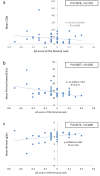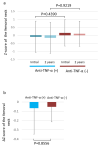Serum N-terminal telopeptide of type I collagen as a biomarker for predicting bone density loss in patients with Crohn disease
- PMID: 33905438
- PMCID: PMC8078791
- DOI: 10.1371/journal.pone.0250658
Serum N-terminal telopeptide of type I collagen as a biomarker for predicting bone density loss in patients with Crohn disease
Abstract
Background: The serum N-terminal telopeptide of type I collagen (NTx) is significantly higher in patients with Crohn disease (CD) than in healthy individuals and patients with ulcerative colitis. This study aimed to investigate whether an elevated serum NTx level is a risk predictor of osteoporosis in patients with CD.
Methods: Based on whether the femoral Z-score decreased over a 2-year period, 41 CD patients were divided into the ΔZ-score <0 group (Z-score decreased) and the ΔZ-score ≥0 group (Z-score did not decrease). The risk predictors of a femoral Z-score decrease were examined. Furthermore, we investigated the correlations between the ΔZ-score (which represents the change in the Z-score over a 2-year period) and the mean levels of biomarkers, including the Crohn Disease Activity Index (CDAI), serum albumin, C-reactive protein, and bone metabolism markers (including NTx) measured initially (i.e., in our previous study) and 2 years later (present study). The relationships between anti-tumor necrosis factor α (anti-TNF-α) therapy and serum NTx levels were also examined.
Results: Although there was no correlation between the mean CDAI and the ΔZ-score, the mean serum NTx and albumin levels were significantly correlated with the ΔZ-score (P<0.01 and P = 0.02, respectively). Furthermore, the femoral Z-score tended to be lower in the anti-TNF-α administration group than in the non-administration group.
Conclusions: These observations indicated that an elevated serum NTx could be a useful marker for predicting a decrease in the femoral bone mineral density in CD patients. Anti-TNF-α therapy maintained an elevated serum NTx level, suggesting that treatment with anti-TNF-α may help control increased bone resorption in CD patients.
Conflict of interest statement
The authors have declared that no competing interests exist.
Figures




Similar articles
-
An Increased Serum N-Terminal Telopeptide of Type I Collagen, a Biochemical Marker of Increased Bone Resorption, Is Associated with Infliximab Therapy in Patients with Crohn's Disease.Dig Dis Sci. 2016 Jan;61(1):99-106. doi: 10.1007/s10620-015-3838-y. Epub 2015 Aug 8. Dig Dis Sci. 2016. PMID: 26254083
-
Bone turnover and mineral density in adult thalassemic patients: relationships with growth hormone secretory status and circulating somatomedins.Endocrine. 2016 Aug;53(2):551-7. doi: 10.1007/s12020-016-0865-1. Epub 2016 Jan 29. Endocrine. 2016. PMID: 26825070
-
Treatment with infliximab is associated with increased markers of bone formation in patients with Crohn's disease.J Clin Gastroenterol. 2006 Jan;40(1):55-63. doi: 10.1097/01.mcg.0000190762.80615.d4. J Clin Gastroenterol. 2006. PMID: 16340635
-
Prolactinomas in adolescents: persistent bone loss after 2 years of prolactin normalization.Clin Endocrinol (Oxf). 2000 Mar;52(3):319-27. doi: 10.1046/j.1365-2265.2000.00902.x. Clin Endocrinol (Oxf). 2000. PMID: 10718830
-
Increased urinary N-telopeptide cross-linked type 1 collagen predicts bone loss in patients with inflammatory bowel disease.Am J Gastroenterol. 2000 Mar;95(3):699-704. doi: 10.1111/j.1572-0241.2000.01850.x. Am J Gastroenterol. 2000. PMID: 10710060
References
MeSH terms
Substances
LinkOut - more resources
Full Text Sources
Medical
Research Materials

